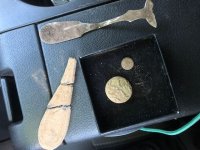Wild Colonial Boy
Hero Member
- Sep 7, 2013
- 599
- 834
- Detector(s) used
- equinox 800
- Primary Interest:
- All Treasure Hunting
I am having no luck in the immediate area (20ft from edge of hole ) around the few cellar holes I detected
i think I am being too selective on only digging good solid signals, When I dig iffy/ good signal mixes its always nails
just watched a Hoover Boys video interview where the say there real luck started when they started digging all signals
I know they use another machine
Just wondering if equinox users are doing this also?
Q and A with Hoover Boy Kurt Franz - Metal Detecting Gear
Thanks
i think I am being too selective on only digging good solid signals, When I dig iffy/ good signal mixes its always nails
just watched a Hoover Boys video interview where the say there real luck started when they started digging all signals
I know they use another machine
Just wondering if equinox users are doing this also?
Q and A with Hoover Boy Kurt Franz - Metal Detecting Gear
Thanks





